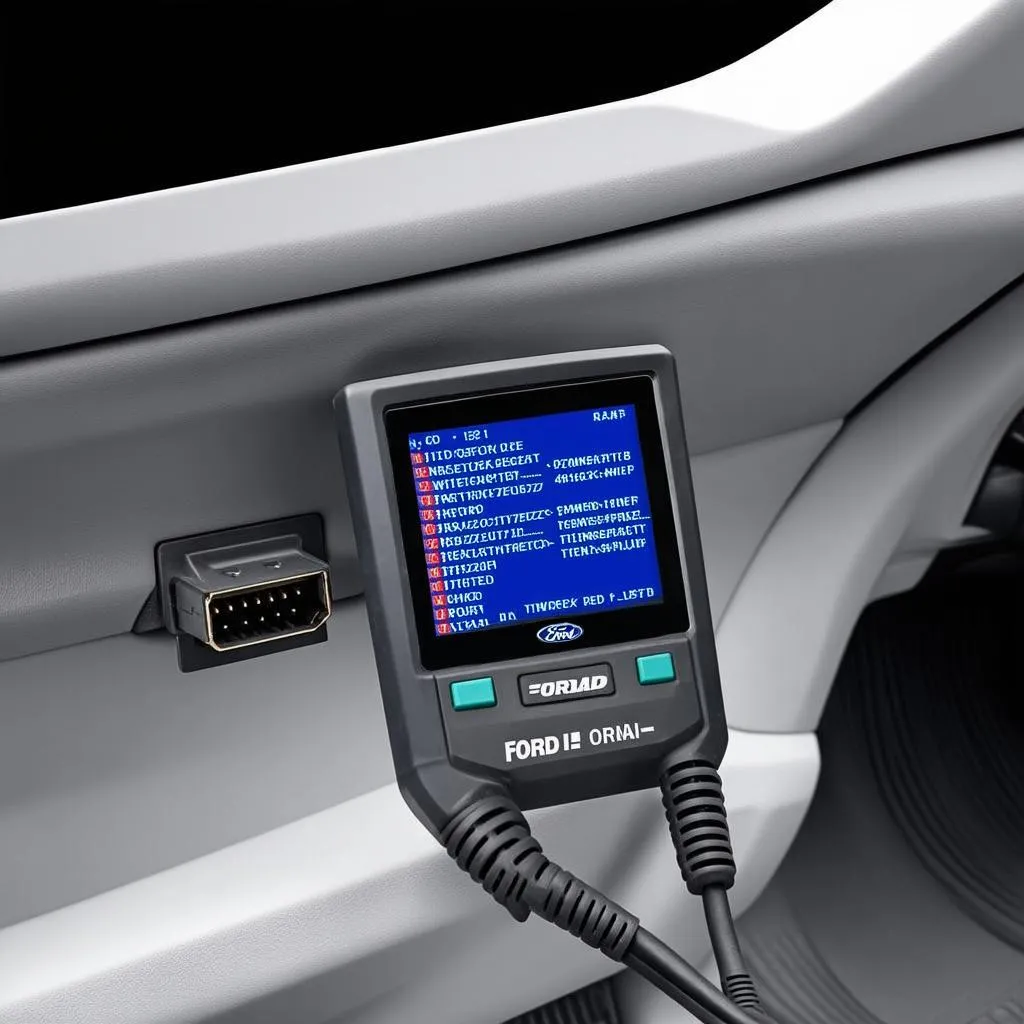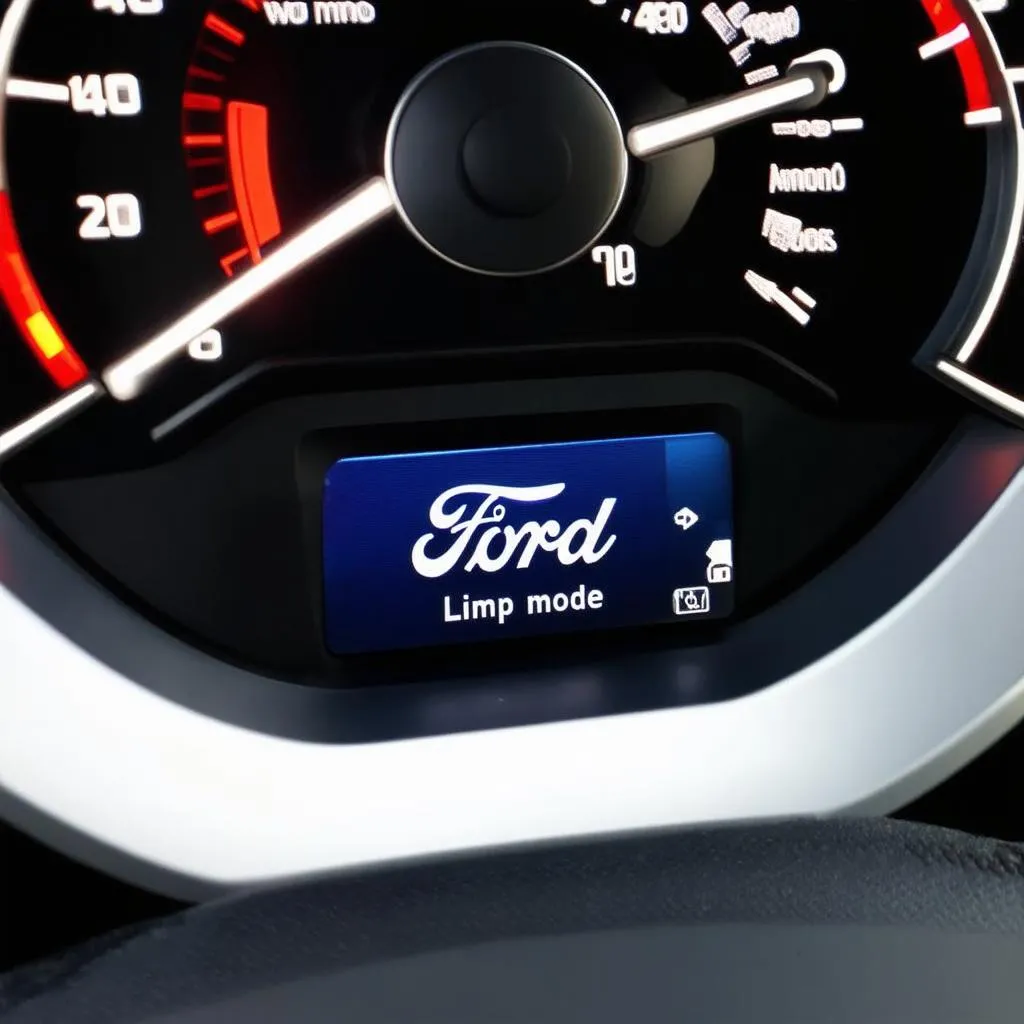Have you ever been cruising down the highway, enjoying the open road, when suddenly your Ford car starts sputtering and loses power? You might be experiencing “limp mode,” a safety feature that limits your car’s performance to prevent further damage. While it can be frustrating, understanding why your Ford OBD II code reader is showing limp mode can help you troubleshoot the issue and get back on the road quickly.
What Does it Mean When Your Ford OBD II Code Reader Shows Limp Mode?
Think of it like a protective shield for your car. When your Ford’s computer system detects a potential problem, it triggers limp mode to prevent further damage. It might sound scary, but it’s actually a good thing!
Imagine this: You’re driving your Ford, and the engine starts to overheat. If your car didn’t go into limp mode, the overheating could lead to serious engine damage. Limp mode ensures you can safely get to a mechanic and avoid any catastrophic failures.
But what causes limp mode? A multitude of factors can trigger this safety feature, ranging from faulty sensors and loose connections to more serious issues with your engine, transmission, or electrical system. It’s crucial to understand the root cause to effectively resolve the problem.
Troubleshooting Ford Limp Mode: Understanding the Code Reader’s Language
The key to understanding limp mode is deciphering the codes your Ford OBD II code reader displays. These codes, like cryptic messages from the car’s computer system, offer valuable insights into what’s going on.
Think of it like this: Imagine you’re trying to understand a foreign language. You wouldn’t just listen to the sounds – you’d need a dictionary to translate them. That’s what the OBD II code reader is for. It translates those cryptic codes into meaningful information that you can use to fix the problem.
Common OBD II Codes Associated With Limp Mode
Here are some common OBD II codes that often appear when your Ford is in limp mode:
- P0171: System Too Lean (Bank 1): This code indicates that the engine is running lean, meaning there’s not enough fuel being injected. This can be caused by issues with the fuel injectors, oxygen sensors, or air intake system.
- P0174: System Too Lean (Bank 2): Similar to P0171, this code suggests a lean condition in the second bank of cylinders.
- P0300: Random/Multiple Cylinder Misfire Detected: This code signifies a misfire in one or more cylinders, which could be caused by faulty spark plugs, ignition coils, or fuel delivery issues.
- P0335: Crankshaft Position Sensor “A” Circuit Malfunction: This code relates to the crankshaft position sensor, which tells the computer where the crankshaft is in its rotation. A faulty sensor can disrupt engine timing and cause misfires.
- P0700: Transmission Control System Malfunction: This code indicates a problem with the transmission control module or other transmission components, which might be causing a loss of power or erratic gear shifting.
How to Decode OBD II Codes: A Step-by-Step Guide
- Connect Your Code Reader: Plug the OBD II code reader into the Diagnostic Connector (DLC) under your car’s dashboard.
- Retrieve the Codes: Follow the instructions provided with your specific code reader to retrieve the stored fault codes.
- Interpret the Codes: Refer to a reputable online OBD II code database or a specialized automotive repair manual to understand the meaning of each code.
- Identify the Cause: The code’s description will usually point to the potential cause of the problem.
- Start Troubleshooting: Based on the identified cause, you can start troubleshooting the issue by checking connections, sensors, and other related components.
Finding the Right OBD II Code Reader: Tips for Choosing the Right Tool
Not all OBD II code readers are created equal. Some are simple and basic, while others offer advanced features and extensive compatibility.
Here are some factors to consider when choosing an OBD II code reader for your Ford:
- Compatibility: Make sure the code reader is compatible with your Ford’s model year and engine type.
- Features: Determine if you need just basic code reading or advanced features like live data streaming, sensor readings, or data logging.
- Ease of Use: Choose a code reader that’s intuitive and user-friendly.
- Price: Budget accordingly and consider the value for money.
Remember, it’s wise to invest in a quality OBD II code reader that can help you diagnose issues proactively and keep your Ford running smoothly.
The Spiritual Connection Between Your Ford and Limp Mode
Some believe there’s a spiritual connection between your Ford and the limp mode it enters. Imagine your car as a living entity with its own energy and emotions. When things aren’t aligned, it might express its distress through limp mode.
Think of it like this: You’re feeling overwhelmed and stressed. Your body might respond with physical symptoms like headaches or fatigue. Similarly, your Ford might experience “limp mode” as a way to signal that something is out of balance.
Here are some spiritual interpretations of limp mode:
- Lack of Attention: Your Ford might be feeling neglected and craving your attention.
- Blocked Energy: There could be energy blockages in your car’s system that are hindering its smooth operation.
- Spiritual Guidance: Limp mode could be a sign from the universe urging you to slow down, reflect, and address any underlying issues.
Consider performing a car cleansing ritual to restore balance and harmony to your Ford. You can use crystals, sage, or simply your intentions to cleanse your car’s energy field.
Other Common Questions About Ford OBD II Code Reader and Limp Mode
Here are some frequently asked questions about Ford OBD II code readers and limp mode:
Q: What should I do if my Ford is in limp mode?
A: The first step is to pull over safely and consult your OBD II code reader. Then, refer to the code interpretation resources mentioned earlier to identify the potential cause. If the issue seems minor, you might be able to address it yourself. However, if the problem appears complex, it’s best to consult a qualified mechanic.
Q: Can I reset the limp mode myself?
A: While you can clear the code reader, the underlying issue causing the limp mode needs to be addressed. Clearing the codes might temporarily resolve the problem, but the limp mode will likely reappear if the issue persists.
Q: Can I drive my Ford in limp mode?
A: It’s generally not recommended to drive your Ford in limp mode for extended periods. While you can drive it slowly and carefully to a mechanic, remember that limp mode limits your car’s performance and can make driving more difficult.
Q: How do I know if my Ford is in limp mode?
A: You might notice a reduced power output, a flashing engine light, or a change in how the car accelerates or shifts gears. Check your OBD II code reader to confirm if limp mode is active.
Q: Is there a way to prevent limp mode?
A: Regular maintenance, including oil changes, air filter replacements, and sensor checks, can help prevent limp mode. It’s also crucial to address any warning lights or unusual noises promptly to avoid major issues.
Discover More Solutions for Your Ford: Explore TechCarUSA.com
This article has provided a comprehensive overview of Ford OBD II code readers, limp mode, and how to troubleshoot related issues. For more in-depth information on specific codes, repair techniques, and Ford-related resources, visit TechCarUSA.com. We offer a wealth of knowledge and resources for car enthusiasts and professionals alike.
Need assistance with diagnostics tools or have specific questions about your Ford? Connect with our team of automotive experts via Whatsapp: +84767531508. We’re here to support you 24/7 with all your automotive needs.
In Conclusion: A Harmony of Technology and Spiritual Awareness
Understanding your Ford’s communication through OBD II code readers and limp mode allows you to address potential issues proactively, preventing major breakdowns and ensuring a smooth driving experience. Remember, your car is an extension of yourself, and respecting its needs through regular maintenance and spiritual awareness can foster a harmonious relationship.
Share your experiences with limp mode in the comments below and let’s continue the conversation.
 Ford OBD II Code Reader
Ford OBD II Code Reader
 Limp Mode Warning Light
Limp Mode Warning Light
 Car Cleansing Ritual
Car Cleansing Ritual